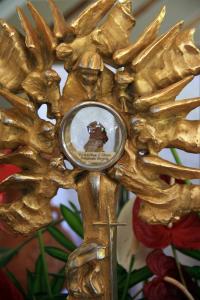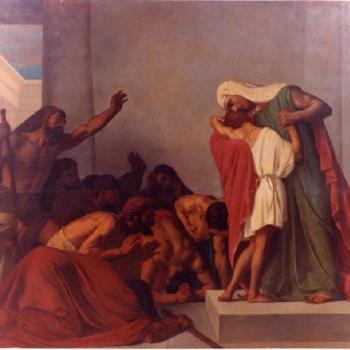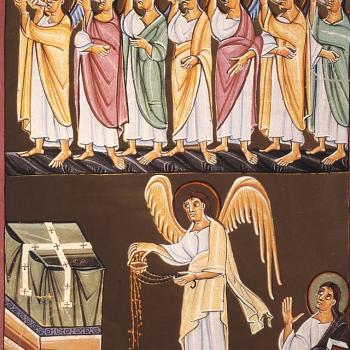Gavin Ortlund is an author, speaker, and apologist for the Christian faith, who serves as the senior pastor of First Baptist Church of Ojai in Ojai, California. Gavin has a Ph.D. from Fuller Theological Seminary in historical theology, and an M.Div from Covenant Theological Seminary. He is the author of seven books as well as numerous academic and popular articles. For a list of publications, see his CV. He runs the YouTube channel Truth Unites, which seeks to provide an “irenic” voice on theology, apologetics, and the Christian life.
I greatly admire and appreciate Gavin’s ecumenical methodology, and viewpoint. It’s extremely refreshing to hear in this hyper-polarized age. He is an exemplary Christian role model of this open-minded, charitable approach. We all learn and “win” when good, constructive dialogue takes place. It’s never a “loss” to arrive at more truth or to recognize one’s own error.
*****
This is a reply to his video, “Relics: A Protestant Critique” (8-28-21). His words will be in blue.
Gavin (as is his usual custom) makes many irenic, conciliatory comments at the beginning, as a way of establishing common ground and getting out of the way things that Catholics and Protestants shouldn’t have to wrangle about. I greatly appreciate this. Such a breath of fresh air . . .
But he certainly disagrees, too, and that’s what I’ll be responding to.
The Protestant concern is that as Church history develops, the use of relics develops and changes, and it gets to a point where it transgresses a boundary into the realm of — I’ll use the words — superstition and idolatry. [6:37-53]
One of the Protestant classical views is that if something isn’t in Scripture, it doesn’t mean you can’t do it, but you shouldn’t insist upon it. [7:25-35]
I will provide a ton of scriptural support (as is my wont) below. Not to worry!
Gavin distinguishes between historical excesses regarding relics and Catholic official teaching. Very good!
He says that Catholics in the past (prior to Protestantism) were “adoring” relics. No doubt some did (and do) — one can always find theological ignorance with little trouble — , but Gavin knows that Catholic teaching utterly condemns this. Only God can be adored and worshiped. He also mentions “kissing, embracing, and bowing to” relics.
Proper and crucial distinctions must be made here. I have often watched relatives of mine kiss a dead mother or son in a casket on the forehead. Does that mean they are worshiping them? No; it’s obviously affection. One can observe the grieving wife of a slain soldier lying on their casket or on their gravestone. Is that idolatry? Obviously not. We know what is going on there. I watched on TV Nancy Reagan lie weeping on the casket of her husband, President Ronald Reagan. I’ve been very moved at the Vietnam War Memorial in Washington, D.C. watching many people crying and touching the names of their friends or relatives who were tragically killed in that ultimately futile conflict. Clearly, many Protestants do these things without any slightest hint of idolatry or worship.
I’ve kissed relics. I was showing respect and honor to the saints involved. I’ve never worshiped anyone but God. And almost all Catholics know this. Bowing to creatures (albeit those who were alive) — including veneration — is explicitly (and massively) biblical.
1 Chronicles 29:20 (RSV) Then David said to all the assembly, “Bless the LORD your God.” And all the assembly blessed the LORD, the God of their fathers, and bowed their heads, and worshiped [shachah] the LORD, and did obeisance [shachah] to the king.*Joshua 5:13-15 When Joshua was by Jericho, he lifted up his eyes and looked, and behold, a man stood before him with his drawn sword in his hand; and Joshua went to him and said to him, “Are you for us, or for our adversaries?” [14] And he said, “No; but as commander of the army of the LORD I have now come.” And Joshua fell on his face to the earth, and worshiped [shachah], and said to him, “What does my lord bid his servant?” [15] And the commander of the LORD’s army said to Joshua, “Put off your shoes from your feet; for the place where you stand is holy.” And Joshua did so.
Genesis 18:1-4, 22 And the LORD appeared to him [Abraham] by the oaks of Mamre, as he sat at the door of his tent in the heat of the day. [2] He lifted up his eyes and looked, and behold, three men stood in front of him. When he saw them, he ran from the tent door to meet them, and bowed [shachah] himself to the earth, [3] and said, “My lord, if I have found favor in your sight, do not pass by your servant. [4] Let a little water be brought, and wash your feet, and rest yourselves under the tree, . . . [22] So the men turned from there, and went toward Sodom; but Abraham still stood before the LORD. (cf. Heb 13:2: “Do not neglect to show hospitality to strangers, for thereby some have entertained angels unawares.”)
The text in-between goes back and forth, referring to “men” or “they” or “them” (18:9, 16) and “The LORD” or first-person address from God (18:10, 13-14, 17-21) interchangeably, for the same phenomenon and personal / physical / verbal encounter. But there are three men here; they can’t all plausibly be God. Two of them were angels (indicated by 18:22 and 19:1). Thus, Abraham bowed down to and venerated them, too.
Genesis 27:29 Let peoples serve you, and nations bow down [shachah] to you. Be lord over your brothers, and may your mother’s sons bow down [shachah] to you. . . .
This is Isaac’s blessing of Jacob.
Genesis 42:6 Now Joseph was governor over the land; he it was who sold to all the people of the land. And Joseph’s brothers came, and bowed themselves [shachah] before him with their faces to the ground.
Genesis 19:1 The two angels came to Sodom in the evening; and Lot was sitting in the gate of Sodom. When Lot saw them, he rose to meet them, and bowed [shachah] himself with his face to the earth,
Lot also clearly venerated two angels, who appear by the text (cf. 18:22 above) to be the same angels whom Abraham had talked to and venerated. They distinguish themselves from the LORD, by saying “the LORD has sent us to destroy [Sodom]” (Gen 19:3).
King Nebuchadnezzar “fell upon his face, and did homage to Daniel” (Dan 2:46; cf. 8:17). Mary Magdalene and Joanna and Mary the mother of James and “other women” (Lk 24:10) “bowed their faces to the ground” before two angels (Lk 24:5). Note that the angels did not tell them not to do so. The Philippian jailer “fell down before Paul and Silas” (Acts 16:29).
Men (apostles) are venerated in the New Testament. The Greek for “fell down before” in Acts 16:29 is prospipto (Strong’s word #4363). It is also used of worship towards Jesus in five passages (Mk 3:11; 5:33; 7:25; Lk 8:28, 47). So why didn’t Paul and Silas rebuke the jailer? I submit that it was because they perceived his act as one of veneration (which is permitted) as opposed to adoration or worship, which is not permitted to be directed towards creatures. Note that the word “worship” doesn’t appear in the above five passages, nor in Luke 24:5 or Acts 16:29. When “worship” [proskuneo] does appear in connection with a man or angel, it isn’t permitted, as in Acts 10:25-26 (St. Peter and Cornelius).
Thus, we see the same in Revelation 19:10 and 22:8-9, because St. John mistakenly thought the angel was Jesus, and so tried to worship / adore the angel. The same thing happened when men thought that Paul and Barnabas were Zeus and Hermes and “wanted to offer sacrifice.” They were rebuked, as mistaken (Acts 14:11-18).
Is all that idolatry, according to the prohibitions of “bowing down” (Ex 20:5; Lev 26:1; Dt 5:8-9; and Mic 5:13). No. All of those passages are strictly about conscious “graven image” idols, meant to replace God. One mustn’t bow to them. But this is obviously not a prohibition of all bowing and veneration, or else the passages above would be presented in the Bible with disapproval (there is not the slightest hint of of that). Was the bronze serpent that Moses made and set up on a pole for men to gaze at and be healed (Num 21:8-9), an “idol” or “graven image”? Obviously not.
Idolatry is a matter of disobedience in the heart towards the one true God. We don’t always need an image to have an idol. Most idols today are non-visual: money, sex, lust for power, convenience, our own pride or intellects; there are all sorts of idols. Anything that replaces God as the most important thing in our life and the universe, is an idol.
The approach of Martin Luther was balanced, sensible, and biblical:
And I say at the outset that according to the law of Moses no other images are forbidden than an image of God which one worships. A crucifix, on the other hand, or any other holy image is not forbidden. (Against the Heavenly Prophets, 1525; Luther’s Works, Vol. 40, 85-86)
Where however images or statues are made without idolatry, then such making of them is not forbidden. [M]y image breakers must also let me keep, wear, and look at a crucifix or a Madonna . . . as long as I do not worship them, but only have them as memorials. (Ibid., 86, 88)
But images for memorial and witness, such as crucifixes and images of saints, are to be tolerated . . . And they are not only to be tolerated, but for the sake of the memorial and the witness they are praiseworthy and honorable . . . (Ibid., 91)
. . . thinking that the power or grace of God inheres in relics, in such a way that if you draw near to the relic, or if you touch the relic, you can become a partaker of that grace or power. [9:22-36]
This is also fairly explicitly biblical:
2 Kings 13:20-21 So Elisha died, and they buried him. Now bands of Moabites used to invade the land in the spring of the year. 21 And as a man was being buried, lo, a marauding band was seen and the man was cast into the grave of Elisha; and as soon as the man touched the bones of Elisha, he revived, and stood on his feet.
Catholic apologist Bertrand Conway elaborates:
The Catholic Church does not teach that there is any magical virtue or any curative efficacy in the relic itself. The Church merely says, following the Scriptures, that they are often the occasion of God’s miracles. In the Old Law we read of the veneration of the Jews for the bones of Joseph (Exodus 13:19; Joshua 24:32), and of the prophet Eliseus which raised a dead man to life (2 Kings 13:21) . . . (The Question Box, 373)
Methodist Adam Clarke, in his Commentary on the above passage, admitted the validity of the principle involved here, even though his subsequent remarks reveal that he doesn’t personally care much for it:
This shows that the prophet did not perform his miracles by any powers of his own, but by the power of God; and he chose to honour his servant, by making even his bones the instrument of another miracle after his death.
Veneration is essentially different from worship or adoration (reserved for God alone); it is a high honor given to something or someone because of the grace revealed or demonstrated in them from God. The relic (and the saint from whom it is derived) reflects the greatness of God just as a masterpiece of art or music reflects the greatness of the artist or composer.
Therefore, in venerating it, God is being honored. The saint is being venerated only insofar as he or she is reflecting God’s grace and holiness. If such an item is worshiped, the person doing it is not following Catholic teaching, which fully agrees with Protestantism with regard to the evil of idolatry, or putting something besides God in the unique place of God.
In the passage above, matter clearly imparted the miraculous and grace from God. That is all that is needed for Catholics to reasonably and scripturally hold such items in the highest regard and honor (veneration).
There are other explicit biblical examples of relics:
2 Kings 2:11-14 “And as they still went on and talked, behold, a chariot of fire and horses of fire separated the two of them. And Elijah went up by a whirlwind into heaven. 12 And Elisha saw it and he cried, ‘My father, my father! the chariots of Israel and its horsemen!’ And he saw him no more. Then he took hold of his own clothes and rent them in two pieces. 13 And he took up the mantle of Elijah that had fallen from him, and went back and stood on the bank of the Jordan. 14 Then he took the mantle of Elijah that had fallen from him, and struck the water, saying, ‘Where is the Lord, the God of Elijah?’ And when he had struck the water, the water was parted to the one side and to the other; and Elisha went over.”
Acts 5:15-16 “. . . they even carried out the sick into the streets, and laid them on beds and pallets, that as Peter came by at least his shadow might fall on some of them. 16 The people also gathered from the towns around Jerusalem, bringing the sick and those afflicted with unclean spirits, and they were all healed.”
Acts 19:11-12 “And God did extraordinary miracles by the hands of Paul, 12 so that handkerchiefs or aprons were carried away from his body to the sick, and diseases left them and the evil spirits came out of them.” (cf. Mt 9:20-22)
Elisha’s bones were a “first-class” relic: from the person himself or herself. These passages, on the other hand, offer examples of “second-class” relics: items that have power because they were connected with a holy person (Elijah’s mantle and even St. Peter’s shadow), and third-class relics: something that has merely touched a holy person or first-class relic (handkerchiefs that had touched St. Paul).
In the Pentateuch, we have a remarkable foreshadowing of relics and specifically of receiving holiness as a result of touching sacred objects:
Exodus 29:37 Seven days you shall make atonement for the altar, and consecrate it, and the altar shall be most holy; whatever touches the altar shall become holy.
Exodus 30:25-29 and you shall make of these a sacred anointing oil blended as by the perfumer; a holy anointing oil it shall be. [26] And you shall anoint with it the tent of meeting and the ark of the testimony, [27] and the table and all its utensils, and the lampstand and its utensils, and the altar of incense, [28] and the altar of burnt offering with all its utensils and the laver and its base; [29] you shall consecrate them, that they may be most holy; whatever touches them will become holy.
Note here that first there is a “holy anointing oil” which is applied to the ark, tabernacle, and related sacred religious items “that they may be most holy.” They in turn impart holiness to all who touch them. If this is not sacramentalism and the underlying principle of relics, nothing is.
God said to Moses about the body of a lamb offered at the temple: “Whatever touches its flesh shall be holy . . .” (Lev 6:27). So now we again have a dead thing (like Elisha’s bones) imparting holiness. How is that any different from Catholic relics? Likewise, the same was said even of the cereal offering (Lev 6:14-18).
Hey, I didn’t write this. It’s the inspired, infallible revelation of God’s Word. Catholics didn’t make this stuff up. But we based our theology on clear biblical indications that mater can (if God wills it) convey grace, holiness, and power.
. . . thinking that prayer is more efficacious or more worthy, if it is made near or while touching a relic . . . [9:53-10:03]
It’s not an exact parallel, but there are similar instances in the Bible, in terms of holy objects. The Israelites bowed down before the temple, while they worshiped and praised and thanked God:
2 Chronicles 7:3 When all the children of Israel saw the fire come down and the glory of the LORD upon the temple, they bowed down with their faces to the earth on the pavement, and worshiped and gave thanks to the LORD, saying, “For he is good,
for his steadfast love endures for ever.”Psalm 138:2 I bow down toward thy holy temple and give thanks to thy name for thy steadfast love and thy faithfulness; . . .
Joshua did the same before the ark of the covenant:
Joshua 7:6 Then Joshua rent his clothes, and fell to the earth upon his face before the ark of the LORD until the evening, he and the elders of Israel; and they put dust upon their heads. [7] And Joshua said, “Alas, O Lord GOD, why hast thou brought this people over the Jordan at all, to give us into the hands of the Amorites, to destroy us? Would that we had been content to dwell beyond the Jordan!”
Levites talked to God before the ark as well:
Deuteronomy 10:8 At that time the LORD set apart the tribe of Levi to carry the ark of the covenant of the LORD, to stand before the LORD to minister to him and to bless in his name, to this day. (cf. 1 Ki 3:15; 8:5; 1 Chr 16:4; 2 Chr 5:6)
Remember, the ark had relics in it, too: “a golden urn holding the manna, and Aaron’s rod that budded, and the tables of the covenant [the two tablets of the Ten Commandments]” (Heb 9:4; cf. Ex 16:33-34; Num 17:10; 1 Ki 8:9; 2 Chr 5:10). The manna (a type of food produced by God to feed the wandering post-Exodus Jews) was biological, so presumably it had to be supernaturally preserved if it lasted very long. Again, the parallels to relics and the practices and principles connected to them is very clear.
God specifically said that He would “meet” people in conjunction with the ark (specifically, the mercy seat on top of it: see Ex 25:22; 30:6; Lev 16:2; cf. 1 Sam 4:4; 2 Sam 6:2; 2 Ki 19:15; 1 Chr 13:6; Ps 80:1; 99:1; Is 37:16; Ezek 10:4; Heb 9:5).
Accordingly, it was thought that holy things (the temple and the ark of the covenant) gave special power and efficacy to prayers. For this reason, the Jews worshiped “toward the temple”:
Psalm 5:7 But I through the abundance of thy steadfast love will enter thy house, I will worship toward thy holy temple in the fear of thee. (cf. 99:9; 134:2; 138:2; Is 27:13)
King Solomon prayed before the sacred altar (both standing and kneeling):
1 Kings 8:22-23 Then Solomon stood before the altar of the LORD in the presence of all the assembly of Israel, and spread forth his hands toward heaven; [23] and said, “O LORD, God of Israel, there is no God like thee, in heaven above or on earth beneath, keeping covenant and showing steadfast love to thy servants who walk before thee with all their heart; (cf. 8:54 [kneeling]; 2 Chr 6:12-14; the Jews swore oaths by the altar in the temple: 2 Chr 6:22)
Daniel prayed to and thanked God in the direction of Jerusalem, three times a day, even from Babylon:
Daniel 6:10 . . . Daniel . . . went to his house where he had windows in his upper chamber open toward Jerusalem; and he got down upon his knees three times a day and prayed and gave thanks before his God, as he had done previously. (cf. 1 Ki 8:44, 48; 2 Chr 6:20-21, 26-27, 29-30, 32-34, 38)
Why? He obviously thought this helped his prayers succeed, or else he wouldn’t have done it.
So how — in light of all of the above — can there possibly be an objection to praying in conjunction with relics? The principle is precisely the same as what we have in the Bible, as far as I can see.
Gavin refers to pilgrimages to relics in order to have more meritorious and efficacious prayer. This is little different from all the Israelite pilgrimages to Jerusalem for the feast days and to offer sacrifice in the temple. There are holy places and holy things in the Bible, and they have power, and this power can transfer in some supernatural way to Christians. These include the bones of Elisha, handkerchiefs that had touched Paul, and the temple and ark of the covenant.
Later he implies that paying a lot of money to do so is improper. But I would also note that we shouldn’t object to a pious Catholic (now or in the Middle Ages) paying a lot of money to make a pilgrimage to a holy place, including seeing and venerating relics, when we have no objection whatsoever to folks going on expensive vacations on yachts, or flying all around the world, spending multiple thousands of dollars (not to mention a host of other arguably materialistic things). If we can go see the wonders of nature or man’s architectural masterpieces, why is it immediately thought to be a “problem” if someone pays money to go on a religious pilgrimage?
I think it’s just a case of “live and let live.” There’s nothing wrong with that, as long as relics are grounded in the Bible, as I have done. But people trying to make money selling fake relics is clearly wrong and the Church condemned that. Trent (posted below) stated: “every superstition shall be removed, all filthy lucre be abolished; finally, all lasciviousness be avoided . . .”
The Protestant movement started with these things [relics and their abuses] . . . [10:50-10:55]
I think this is historically exaggerated, at best. Even Martin Luther (who started the Protestant movement, after all) advocated the goodness and propriety of relics after his 95 Theses (October 1517) and even after the Diet of Worms (January-May 1521):
[W]e ought to encase the bones of saints in silver; this is good and proper. (Sermons I, ed. and tr. John W. Doberstein; Sermon on the Man Born Blind, 17 March 1518; in Luther’s Works, vol. 51)
Many make pilgrimages to Rome and to other holy places to see the robe of Christ, the bones of the martyrs, and the places and remains of the saints, which we certainly do not condemn. (Explanations of the Ninety-Five Theses, Aug. 1518; tr. Carl W. Folkemer; in Luther’s Works, vol. 31)
These many years your Grace has been acquiring relics in every land; but God has now heard your Grace’s request and has sent your Grace, without cost or trouble, a whole cross, with nails, spears and scourges. I say again, grace and joy from God on the acquisition of the new relic! (To the Elector Frederic of Saxony, end of Feb. 1522; in Luther’s Correspondence and Other Contemporary Letters, Vol. II: 1521-1530; translated and edited by Preserved Smith and Charles M. Jacobs [Philadelphia: The Lutheran Publication Society: 1918] )
Luther’s 95 Theses never even mentioned relics, which makes sense, since he wrote all three of the above statements after the time of the 95 Theses.
Gavin wishes that Trent had done more with respect to curbing abuses having to do with relics. But in a pinned comment underneath, he wrote: “One thing I wish I had done better in this video is describe specifically how Trent did seek to curb abuses with respect to relics. While Trent did not address the Protestant concerns about idolatry and superstition sufficiently, in my view, it did condemn a number of other abuses, and I don’t want to be unfair in failing to mention that.” He then cites “the entirety of the second decree of Session 25 of Trent” [link]. Here are the highlights, where Trent specifically addressed abuses and corruptions and impieties:
Moreover, that the images of Christ, of the Virgin Mother of God, and of the other saints, are to be had and retained particularly in temples, and that due honour and veneration are to be given them; not that any divinity, or virtue, is believed to be in them, on account of which they are to be worshipped; or that anything is to be asked of them; or, that trust is to be reposed in images, as was of old done by the Gentiles who placed their hope in idols; but because the honour which is shown them is referred to the prototypes which those images represent; in such wise that by the images which we kiss, and before which we uncover the head, and prostrate ourselves, we adore Christ; and we venerate the saints, whose similitude they bear: as, by the decrees of Councils, and especially of the second Synod of Nicaea, has been defined against the opponents of images. . . .
And if any abuses have crept in amongst these holy and salutary observances, the holy Synod ardently desires that they be utterly abolished; in such wise that no images, (suggestive) of false doctrine, and furnishing occasion of dangerous error to the uneducated, be set up. And if at times, when expedient for the unlettered people; it happen that the facts and narratives of sacred Scripture are portrayed and represented; the people shall be taught, that not thereby is the Divinity represented, as though it could be seen by the eyes of the body, or be portrayed by colours or figures.
Moreover, in the invocation of saints, the veneration of relics, and the sacred use of images, every superstition shall be removed, all filthy lucre be abolished; finally, all lasciviousness be avoided; in such wise that figures shall not be painted or adorned with a beauty exciting to lust; nor the celebration of the saints, and the visitation of relics be by any perverted into revellings and drunkenness; as if festivals are celebrated to the honour of the saints by luxury and wantonness.
In fine, let so great care and diligence be used herein by bishops, as that there be nothing seen that is disorderly, or that is unbecomingly or confusedly arranged, nothing that is profane, nothing indecorous, seeing that holiness becometh the house of God.
Thanks to Gavin for posting these statements. Saved me the trouble! He does protest in the video that Trent said nothing about “veneration.” It didn’t need to, since such veneration of holy objects and holy persons is expressly biblical; so is bowing before them, as I have massively shown above. Gavin’s argument then needs to shift to showing how all these biblical indications are not as I have claimed. Best wishes in that endeavor! If you find yourself fighting against the Bible, it’s time to change your view. That’s not a good place to be.
He repeatedly asks where we should draw the line between a proper use of relics and a corrupt, idolatrous one. Well, he already said it (and we fully agree): if they become idols in place of God or are used for financial gain, or are thought to be magic charms (superstition), that’s wrong, and the line has been crossed. The understanding of them has to be sacramental and incarnational, and grounded in a proper biblical understanding of the veneration of saints.
Superstition and idolatry are — like lust or pride or greed — erroneous and wicked attitudes that reside in someone’s heart. We don’t usually know if this is what they are thinking simply by observing outward actions. Two people could be bowing before a relic. One is in fact (if we knew their inner attitude) viewing it as a charm or an idol, and is gravely sinning. The other is venerating it, which is perfectly biblical and Catholic. So the lines are difficult to determine, based on these inherently subjective factors. It’s not a simple matter.
For example, the whole distinction: first-class, second-class, third-class relics; that takes time to develop. You really don’t see second-class relics early on. That’s like more 4th or 5th century. Early on it’s just first-class relics. [16:20-34]
Why is this considered problematic, seeing that all doctrines took time to develop? The canon of the Bible was only finally determined at the end of the 4th century. The doctrines of Christology and trinitarianism kept developing several centuries after that. Educated Protestants (including Gavin ) know this. So why do they make exceptions to the general rule, simply because they disagree with a given doctrine? But I contend that this understanding was early in the sense that it was in the Bible. I showed that above. I’ll repeat it again, reworded a bit:
Elisha’s bones were a “first-class” relic: from the person himself or herself. “Second-class” relics are items that have power because they were connected with a holy person. Elijah’s mantle and St. Peter’s shadow are biblical examples of that. The third-class relic is something that has merely touched a holy person or first-class relic. Handkerchiefs that had touched St. Paul fit that bill. Just because the specific terminology isn’t there doesn’t mean that the concepts are not. The word “Trinity” is not a biblical one, either. So what? The concept and the truthfulness of that doctrine is taught in the Bible.
My wedding ring is massively a third-class relic, seeing that it touched a hundred holy things in the Holy Land in 2014.
Likewise, he says that bowing to relics didn’t happen in the second century. It didn’t have to, and we wouldn’t expect it to. It was already in effect contained in the Bible, as I have shown.
In Holy Scripture, there’s really nothing exactly like a contemporary Catholic practice of relics. [20:03-10]
I vigorously disagree, and I think I have made a very robust case from Scripture (seen above and in many other articles of mine): infinitely more in-depth than, for example, the typical Protestant desperate attempt to locate sola Scriptura in the Bible (where “the emperor is naked” was never more apt in description). I challenge Gavin or anyone else to grapple with what I have brought to the table. The discussion is not complete until that is done.
Gavin (with just seven minutes to go in his video) does finally mention some Catholic evidences for relics: Peter’s shadow, Paul’s handkerchiefs, the body of Elisha, but (disappointingly) immediately dismisses them and says (rather astonishingly to me) that they have little connection to Catholic beliefs and practices regarding relics. Dismissal is not an argument; it’s merely a declarative statement, sans argument. So I hope he will interact with this reply.
He says that in the Bible, people didn’t collect and venerate bones; they simply buried people. But of course, a proper burial is honoring a person, and visiting gravesites (as every Protestant has done) is not wholly unlike giving homage to holy persons and saints and making pilgrimages to their gravesites or relics connected with them. This is nowhere more evident than in the extreme reverence that Jews to this day give to gravesites of their heroes of the faith. I observed this firsthand in Israel in 2014 at Rachel’s tomb and King David’s. These are very holy places, and they are acting just as their ancestors did.
He brings up Elisha’s bones and makes the point that it was a one-time occurrence and that it was not imitated, at least in the earlier centuries. Again, this is to be expected. A full understanding of many doctrines (and even of the canon of Scripture) habitually took several centuries. And it is also expected that there will be corruptions (as with everything else) when the more fully developed doctrine is in place many centuries later. The history of the human race is a record of continual flourishing, decay and corruption, and then revival. Christians do this just like everyone else does, because we are fallen sinners like everyone else.
The cogent point with Elisha is that the underlying principle is supported: items from the body of holy persons or connected with them in some fashion have power and convey grace. This was true in this instance, and with Elijah’s mantle, and Peter’s shadow and Paul’s handkerchiefs, and Gavin has not given us any reason to doubt this. It’s also indirectly supported in many ways by Jesus using saliva to heal people, touching them, having the hem of His garment touched, bringing about healing, etc. There was almost always physicality. He didn’t usually just proclaim the healing:
Matthew 9:25 . . . he went in and took her by the hand, and the girl arose [from the dead]. (cf. Mk 5:41)
Matthew 20:34 And Jesus in pity touched their eyes, and immediately they received their sight and followed him.
Mark 1:31 And he came and took her by the hand and lifted her up, and the fever left her; . . .
Luke 8:46 But Jesus said, “Some one touched me; for I perceive that power has gone forth from me.”
Luke 22:51 . . . And he touched his ear and healed him.
This is the other underlying premise: sacramentalism in conjunction with the incarnation. Matter can and does convey God’s grace. It does so in baptism, Holy Communion, and in many other ways. It was the same with the apostles:
Acts 5:12 Now many signs and wonders were done among the people by the hands of the apostles. . . .
Acts 19:6 And when Paul had laid his hands upon them, the Holy Spirit came on them; and they spoke with tongues and prophesied.
Acts 19:11 And God did extraordinary miracles by the hands of Paul,
If relics (in their practice) are so unbiblical, why is it that God commanded manna (a second-class relic of God Himself, so to speak) to be kept?:
Exodus 16:32-34 And Moses said, “This is what the LORD has commanded: `Let an omer of it be kept throughout your generations, that they may see the bread with which I fed you in the wilderness, when I brought you out of the land of Egypt.'” [33] And Moses said to Aaron, “Take a jar, and put an omer of manna in it, and place it before the LORD, to be kept throughout your generations.” [34] As the LORD commanded Moses, so Aaron placed it before the testimony, to be kept.
Why? What was the purpose? Why wasn’t the written biblical record enough? Why did God also command Moses to keep Aaron’s staff (Num 17:10), to also be kept in the ark? That was a second-class relic of Aaron. Both, along with the tablets of the Ten Commandments (a second-class relic of Moses), were kept in the ark of the covenant, which we have seen was regarded as a great aid in prayer, praise, petitions to God, and the holiest item in the Jewish religion, just as the Wailing Wall is today, because it was connected with the temple; and they pray there as a result and believe that the prayers will be especially efficacious. I was honored and privileged to do the same.
He notes that human being tend to become idolaters. The solution to that is to reform hearts and transform souls by the power of God, prayer, grace, and conversion of heart. The answer is not to eliminate every practice that might produce idolatry in such people. Lots of people make the Bible an idol, or find doctrines in it that simply aren’t there. Does that mean we get rid of the Bible, which arguably “caused” all the false doctrines floating around? No, we correct and educate such people and push them in the right direction.
It’s no different in Protestantism. Sola fide (faith alone) is sadly all too often corrupted into antinomianism. Love of the Bible becomes bibliolatry or a radical Bible Alone position. Private judgment devolves into rampant sectarianism and denominationalism. The various denominations don’t teach these things, but they are rampant “on the ground”: just as Gavin repeatedly says about Catholicism and relics. How are they solved? By getting rid of justification by faith or the Bible or the Protestant principle of private judgment? No; that’s no solution to anything. It’s by proper understanding and teaching folks who have gone astray within a given worldview. We don’t throw the baby out with the bathwater. We reform the practice and foster a right understanding of the essential meaning underneath and behind it.
***
Practical Matters: Perhaps some of my 4,000+ free online articles (the most comprehensive “one-stop” Catholic apologetics site) or fifty books have helped you (by God’s grace) to decide to become Catholic or to return to the Church, or better understand some doctrines and why we believe them.
Or you may believe my work is worthy to support for the purpose of apologetics and evangelism in general. If so, please seriously consider a much-needed financial contribution. I’m always in need of more funds: especially monthly support. “The laborer is worthy of his wages” (1 Tim 5:18, NKJV). 1 December 2021 was my 20th anniversary as a full-time Catholic apologist, and February 2022 marked the 25th anniversary of my blog.
PayPal donations are the easiest: just send to my email address: [email protected]. You’ll see the term “Catholic Used Book Service”, which is my old side-business. To learn about the different methods of contributing, including 100% tax deduction, etc., see my page: About Catholic Apologist Dave Armstrong / Donation Information. Thanks a million from the bottom of my heart!
***
Photo credit: Relic of St. Clare of Assisi; photograph by Judy Flores Partlow, 18 April 2012 [Flickr / CC BY 2.0 license]
***
Summary: Baptist pastor Gavin Ortlund provides a critique of the Catholic practice of venerating relics, concentrating on agreed-with corruptions. I give a ton of Bible proofs.














